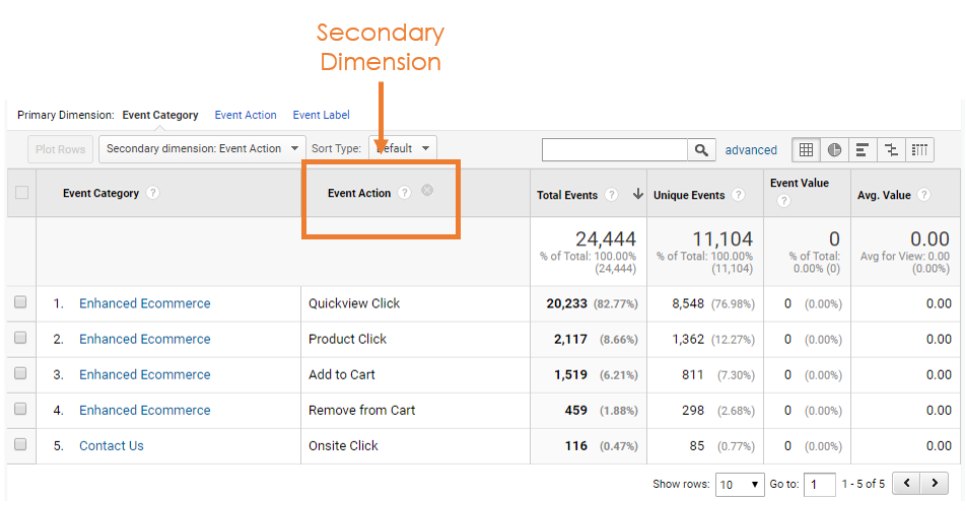Grasping Google Analytics: Utilizing Secondary Dimension for Deeper Analysis
Grasping Google Analytics: Utilizing Secondary Dimension for Deeper Analysis
Blog Article
Opening the Power of Second Dimension Analytics for Enhanced Data Insights and Decision-Making
In the realm of data analytics, main dimensions typically take the limelight, yet the real deepness of understandings lies within the realm of additional dimensions. By harnessing the power of secondary dimension analytics, organizations can introduce concealed trends, reveal connections, and essence a lot more meaningful verdicts from their information.
Significance of Secondary Dimensions
Discovering the importance of additional dimensions in analytics reveals the hidden layers of information understandings critical for educated decision-making in various domains. Second dimensions give a deeper understanding of main information by supplying added context and viewpoints. By including second dimensions right into analytics, companies can remove more nuanced and extensive understandings from their datasets.
One trick relevance of additional measurements is their ability to section and categorize main data, enabling for an extra thorough analysis of particular subsets within a dataset. This division makes it possible for businesses to recognize patterns, fads, and outliers that may not be evident when checking out the information as a whole. Additional dimensions help in uncovering connections and reliances in between different variables, leading to even more accurate projecting and anticipating modeling - secondary dimension.
Additionally, secondary measurements play a crucial role in enhancing data visualization and coverage. By adding additional dimensions to visualizations, such as graphs or graphes, experts can create a lot more interesting and informative representations of data, facilitating much better interaction of findings to stakeholders. Generally, the assimilation of secondary dimensions in analytics contributes in unlocking the complete capacity of information and driving evidence-based decision-making.
Secret Benefits of Utilizing Secondary Dimensions
Utilizing second measurements in analytics supplies companies a tactical benefit by enhancing the depth and granularity of information understandings. One crucial advantage of incorporating secondary measurements is the capacity to section and filter information, enabling for an extra comprehensive evaluation of certain aspects within a dataset. This segmentation allows companies to gain an extra nuanced understanding of their target market, performance metrics, and various other critical information points. By dissecting information using secondary dimensions such as time, area, device type, or customer demographics, companies can uncover patterns, fads, and correlations that may otherwise remain covert.
Furthermore, the application of additional dimensions improves the context in which main data is analyzed. By leveraging second measurements in analytics, companies can harness the complete potential of their data to drive better decision-making and attain their business purposes.
Advanced Data Evaluation Strategies
A deep study innovative data analysis strategies reveals advanced approaches for extracting useful understandings from complex datasets. One such technique is device understanding, where algorithms are utilized to recognize patterns within data, predict end results, and make Find Out More data-driven decisions. This method permits the automation of analytical version building, making it possible for the processing of large volumes of information at a faster speed than typical methods.
An additional advanced technique is predictive analytics, which uses analytical formulas and machine understanding methods to forecast future end results based upon historical data. By evaluating patterns and patterns, businesses can anticipate customer actions, market fads, and possible threats, encouraging them to make proactive choices.
Moreover, text mining and view evaluation are beneficial techniques for drawing out understandings from unstructured information sources such as social media comments, client Visit Your URL testimonials, and study actions. By analyzing text data, organizations can understand consumer point of views, determine arising patterns, and enhance their products or services based on comments.
Enhancing Decision-Making Through Additional Measurements

Enhancing decision-making through second dimensions enables services to make even more educated and targeted calculated choices. For instance, by segmenting consumer information based upon secondary dimensions like acquiring history or engagement levels, business can tailor their advertising approaches to certain audience sections, leading to enhanced conversion prices and customer fulfillment. Additional dimensions can assist determine connections and partnerships in between various variables, making it possible for organizations to make data-driven decisions that drive development and profitability.
Carrying Out Second Dimension Analytics
When incorporating additional measurements in analytics, organizations can open deeper understandings that drive critical decision-making and enhance general performance. Implementing secondary dimension analytics calls for an organized strategy to make certain efficient usage of this powerful tool. The initial action is to identify the key metrics and measurements that align with the organization's strategic objectives. This involves recognizing the specific inquiries the organization looks for to answer and the information factors needed to resolve them.

Additionally, companies need to take advantage of advanced analytics devices and technologies to enhance the procedure of integrating second measurements. These tools can automate data processing, analysis, and visualization, permitting companies to concentrate on translating insights instead of hands-on data manipulation.
Conclusion
In verdict, second dimension analytics play a vital role in improving data understandings and decision-making procedures. By making use of sophisticated data evaluation techniques and carrying out secondary measurements properly, companies can open the power of their data to drive tactical business choices.
In the realm of information analytics, key dimensions frequently take the spotlight, but the true deepness of understandings exists within the realm of additional measurements.Making use of second measurements in analytics uses companies a tactical advantage by enhancing the deepness and granularity of information understandings. By leveraging second dimensions in analytics, organizations can harness the complete capacity of their information to drive far better decision-making and achieve their company purposes.
Executing information visit here validation processes and normal audits can aid preserve data quality and reliability.
By utilizing sophisticated data evaluation methods and executing secondary dimensions properly, organizations can open the power of their data to drive tactical organization choices.
Report this page